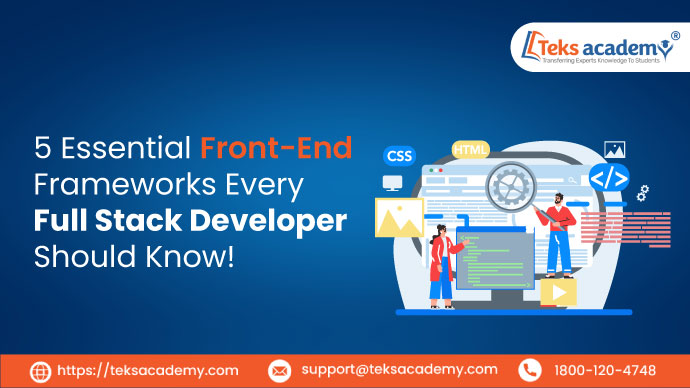While designing web applications, knowing the right framework will help you to make a better application. Firstly, let us understand “What is the framework?” In simple, the framework is a pre-written collection of HTML, CSS, and JavaScript codes. This will be used by the web developers to build the websites more efficiently.
With the full stack development course, you can gain knowledge regarding these frameworks. You can also get clarity regarding each framework and get to know how it matches your application requirements.
What is Full-Stack Development?
Full Stack Development is the process of building an entire web application from start to end. The steps in this process include:
- Designing.
- Writing the code.
- Testing.
- Deploying.
- Monitoring the performance.
Full stack development is the complete process of building a software application. It involves working with various technologies to develop:
- Front-end.
- Back-end.
- Database.
Front- end can also be mentioned as “Client-Side”. It deals with everything that users will interact with directly. Like user interface and user experience. It allows users to access, use the features, and functions of the systems. The client software runs on a user’s local machine such as computers or smartphones. The technologies used in front-end development are:
- HTML
- CSS
- JavaScript
- Bootstrap, etc.
The back end is also called as “Server-Side”. It handles the behind-the-scenes logic and server interactions that support the front end. Manages and coordinates all the activities performed by the server. Also ensures that different server components are functioning correctly. The technologies used in back-end development are:
- Django
- Spring Boot
- MongoDB,
- Nodejs, etc.
Who is a Full-Stack Developer?
What exactly do you mean by the term “Full-Stack”? In simple, full-stack is the collection of tools, technologies, and programming languages. Which are required to develop and deploy the applications.
“Who is a Full-Stack Developer”? So, the Full-stack developers is the individual who can develop both front-end and back-end software. The full-stack developers needs a clear understanding of tools, technologies, and programming languages. Which are used for both client-side and server-side development.
A full-stack developer must have full-stack development skills. And the ability to complete a web application independently. This also includes working on:
- Native application stacks.
- Mobile stacks.
- Web application stacks.
With the relevant full-stack development skills, there are trending job roles. Namely:
- Full-Stack Developer
- Web Application Developer
- Software Engineer
- Mobile App Developer and more.
So instead of concentrating only on either front-end or back-end, learn skills that are useful to become a full-stack developer.
Top 5 Important Front-End Development Frameworks!
The front-end development frameworks will be helpful for the developers to build the website more efficiently without any hassle. These will be useful to make their work easy, especially on performing monotonous tasks. Now let us know the top 5 essential front-end frameworks:
- Angular.js
- Vue.js
- Next.js
- Bootstrap
- Tailwind CSS
Angular
Angular is the most popular open-source JavaScript front-end framework. Developed by Google as the type scripted front-end framework. It is primarily designed for creating single-page web applications and dynamic web applications. To organize the code efficiently and improve the application structure, the angular will follow:
- Model-View-Controller (MVC)
- Model-View-View-Controller (MVVM)
Key Features:
- With Two-way data binding, it will allow automatic synchronization of data.
- The dependency injection will manage the dependencies between the components of the system.
- Develops complex applications faster and has reusable codes.
Vue.js
Vue.js is a JavaScript front-end framework used for building User interfaces. It supports declarative and component-based development. This makes constructing user interfaces easier. It is the most popular framework among the developers. Because of its advantages like flexibility, lightweight, and easy to learn.
Key Features:
- Because of component-based architecture, it enables in creating of modular and composable UI elements.
- As for flexibility and versatility, it is used for building various types of applications.
- The Virtual DOM helps in improving performance by reducing the number of direct manipulations.
Next.js
Next.js is the popular open-source JavaScript framework. This is very useful for developers to create user-oriented and high-performance websites. Which will work well and deliver the expected outcomes. A straightforward front-end framework allows developers to put static and dynamic attributes together.
Key Features:
- The server-side rendering will improve the performance of the application. As it renders the pages on the server before sending them to the client.
- The static-site generation will build the static websites faster and reduce the server load.
- Developers can create backend API endpoints without needing a separate backend.
Bootstrap
Bootstrap is the ultimate front-end framework. Which is mostly used by front-end developers. As a trending framework, you can create responsive and mobile-first websites. It is simple to use and adaptable as per your project’s unique requirements. It includes pre-built components, templates, and utilities that can create a wide range of UI elements and layouts.
Key Features:
- A responsive grid system will create responsive designs that adapt to different device types.
- Cross-browser compatibility will ensure that applications work consistently across different browsers and devices.
- Because of large and active communities, the bootstrap will provide support, resources, and plugins.
Tailwind CSS
Tailwind CSS is a highly customizable framework. It provides a wide range of configuration options. With the pre-built classes, used for building quick responsive web designs. It has a large number of utility classes, including layouts, colors, borders, and more.
Key Features:
- With the utility-first approach, the classes are used to apply styling to HTML elements.
- As a customizable design system, it allows developers to create unique and consistent designs.
- Because pre-built classes, it allows for faster development time.
Conclusion:
In the end, there are many great front-end frameworks available for full-stack web developers. From those, the developer can choose the framework by looking at their key features. Here we have discussed the top 5 trending front-end frameworks. Which will help the full-stack developers make their work easy. Now you can decide which one is the best fit for your project.






